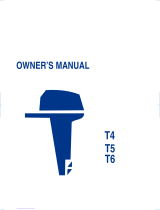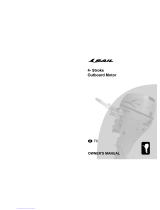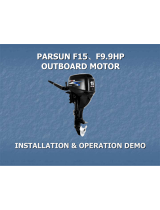
19
6
PRE-OPERATING PREPARATIONS
ENOM00030-A
ENOW000017-0
Use of improper gasoline can damage your
engine. Engine damage resulting from the
use of improper gasoline is considered
misuse of the engine, and damage caused
thereby will not be covered under the lim-
ited warranty.
ENOM00031-A
FUEL RATING
TOHATSU engines will operate satisfacto-
rily when using a major brand of unleaded
gasoline meeting the following specifica-
tions:
USA and Canada — having a posted
pump Octane Rating of 87 (R+M)/2 mini-
mum. Premium gasoline (92 [R+M]/2
Octane) is also acceptable. Do not use
leaded gasoline.
Outside USA and Canada — Use
unleaded gasoline with declared octane
rating of 91 RON or over. Use of premium
gasoline of 98 RON is also allowed.
ENOM00032-A
GASOLINES CONTAINING
ALCOHOL
The fuel system components on your
TOHATSU engine will withstand up to 10%
ethyl alcohol (hererinafter referred to as the
"ethanol"), content in the gasoline. But if
the gasoline in your area contains ethanol,
you should be aware of certain adverse
effects that can occur. Increasing the per-
centage of ethanol in the fuel can also
worsen these adverse effects. Some of
these adverse effects are caused because
the ethanol in the gasoline can absorb
moisture from the air, resulting in a separa-
tion of the water/ethanol from the gasoline
in the fuel tank.
These may cause increased:
zCorrosion of metal parts
zDeterioration of rubber or plastic parts
zFuel permeation through rubber fuel
lines
zStarting and operating difficulties
If the use of gasoline containing alcohol is
inevitable, or presence of alcohol is sus-
pected in the gasoline, it is recommended
to add a filter that has water separating
capability, and check the fuel system for
leaks and mechanical parts for corrosion
and abnormal wear more frequently.
And, in case any of such abnormality is
found, discontinue the use of such gaso-
line and contact our dealer immediately.
If the outboard motor will only be used
infrequently, please see the remarks on
fuel deterioration in the STORAGE chapter
(P 51) for additional information.
ENOW00020-0
When operating a TOHATSU engine on
gasoline containing alcohol, storage of
gasoline in the fuel tank for long periods
should be avoided. Long periods of stor-
age, common to boats, create unique prob-
lems. In cars, alcohol blend fuels normally
are consumed before they can absorb
enough moisture to cause trouble, but
boats often sit idle long enough for phase
separation to take place. In addition, inter-
nal corrosion may take place during stor-
1. Fuel handling
CAUTION
CAUTION






















